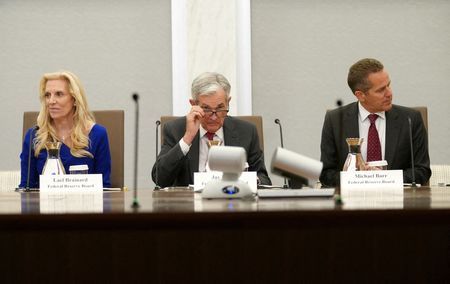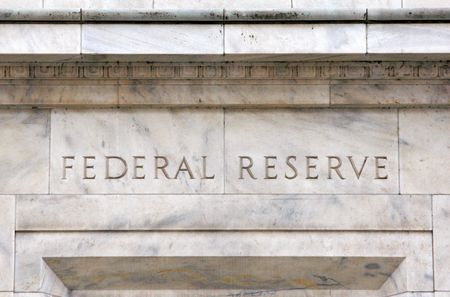By Michael S. Derby
NEW YORK (Reuters) – Fears that aggressive Federal Reserve interest rate rises would break the Treasury bond market have failed to come to fruition so far, even as experts say this critical borrowing sector still needs structural reforms to be on its firmest footing.
Treasury market liquidity has been hit by the U.S. central bank’s sharp move up from near-zero short-term rates in March. But volatile pricing and difficulty trading has not impaired the market’s fundamental functionality, which is critical, given the role U.S. government securities provide as a benchmark for borrowing around the world, market watchers say.
“It’s not crazy to worry about the fragility of the Treasury market” in light of other recent episodes of turbulence, such as the onset of the coronavirus pandemic in the spring of 2020, said Jeremy Stein, an economics professor at Harvard University who served as a Fed governor nearly a decade ago.
But even with this year’s difficulties, Stein said the market has shown surprising resilience in the face of super-sized Fed rate rises. “If you told me a year ago they were going to go 75 (basis points) at a meeting, I would have said, ‘Are you nuts? They’re going to blow up the market.'”
But the central bank hasn’t done so, at least so far. A string of four straight 75-basis-point rate hikes has lifted the central bank’s overnight target rate to between 3.75% and 4.00% on the way toward something even higher by next year. Rate hikes, both realized and expected, have caused market participants to pull back on trading in the face of uncertainty. But they haven’t stopped them from trading altogether.
The Fed’s policy path, “for all the talk of crashing the economy and breaking the financial markets, it hasn’t done that,” Fed Governor Christopher Waller said on Sunday.
LIQUIDITY CHALLENGED, FUNCTIONALITY HOLDS
“The liquidity in the Treasury market is not good,” said Roberto Perli, head of global policy research at Piper Sandler. But “we cannot really say the markets are dysfunctional at this point in the sense that rates move in the direction they’re supposed to move” when new data arrives.
Many experts say, as they have for some time, that the Treasury market needs structural reforms to ensure it stands on the firmest footing, an issue that will be a central discussion point on Wednesday when the New York Fed convenes a conference about the state of the Treasury market, the world’s largest bond market. One reform would be for regulators to soften some capital regulations for banks, for example, that some argue are discouraging dealers from being more active players in the market.
But even absent that, experts believe the Treasury market can withstand the still-uncertain environment ahead. One reason is the Fed’s new Standing Repo Facility, adopted in July 2021, which allows eligible firms to swap their Treasuries for short-term cash loans. That could save the Fed from having to intervene with bond purchases to smooth market conditions, as it did in March 2020.
The Fed is currently trying to shrink its massive holdings as part of its broader campaign to boost the cost of borrowing. After the Bank of England was forced to reverse course and buy bonds to deal with an unexpected blowup in its home bond market, some have feared the same could happen with Treasuries. That could cause confusion about the Fed’s commitment to lowering inflation, given that such purchases could be viewed as stimulus.
THE KNOWN UNKNOWNS
The relative resiliency of the Treasury market in the face of aggressive rate rises has also been mirrored in other parts of the market, to officials’ relief. But that doesn’t mean that they believe there are no risks they might face.
On Tuesday, Fed Vice Chair Michael Barr, the central bank’s point person on financial issues, told Congress “we remain attentive to these and other developments and are closely supervising our regulated institutions to assess potential risks and implications for the stability of the U.S. and global financial systems.”
Cleveland Fed President Loretta Mester said last week that her main concern revolves around the risks that might come out of parts of the market that are less regulated, a point Barr echoed in his congressional testimony. So far, Fed officials do not appear to view the latest tribulations of the cryptocurrency sector as something that threatens the broader financial market, but they are watching nonetheless.
Steven Kelly, senior research associate at the Yale Program on Financial Stability, said that broadly speaking, “the conditions are there for a market to break. That’s not necessarily systemic, but it’s a market stability issue.”
As for the Treasury market, there’s hope that if it hasn’t broken yet, it won’t in the near future. That’s due to a shift in the policy outlook: Fed officials have over recent days signaled an openness to moderate the pace of rate rises as some data shows inflation may be finally starting to cool off.
“Some of the pressures on the markets will start to ease” as the Fed changes gears, said John Canavan, a bond strategist with Oxford Economics. As a force to weigh on markets, “so much of what we’ve been seeing is massive rate hikes and exceptional inflation,” and those factors may now be easing, which could cushion the market, he said.
(Reporting by Michael S. Derby; Editing by Dan Burns and Paul Simao)


